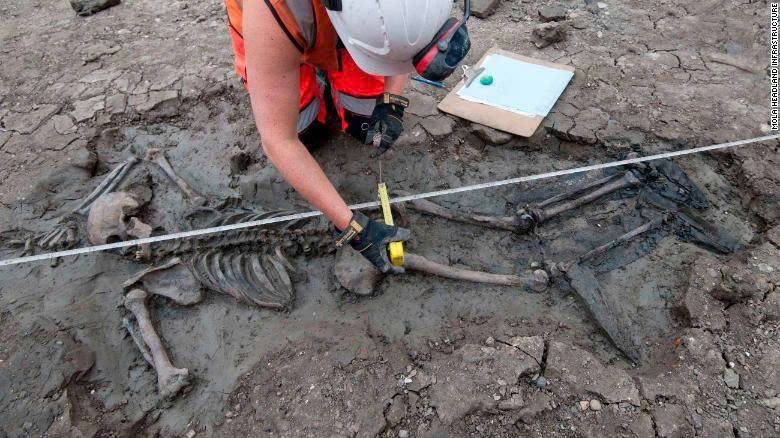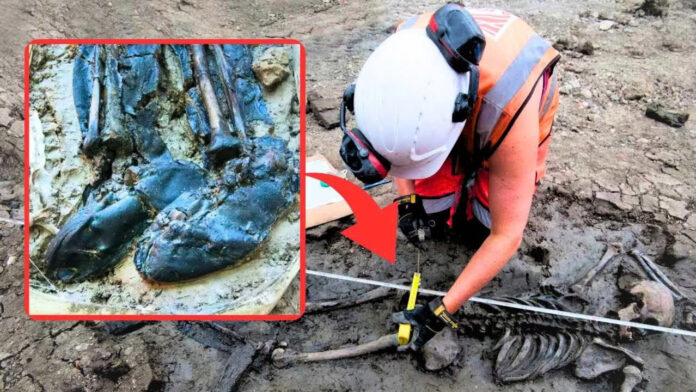Discovery Along London’s Historic Riverbank
Construction workers building London’s massive new sewage system made an extraordinary discovery that has captivated archaeologists worldwide. While excavating near the Thames in Bermondsey, south London, they uncovered the remains of a man who died approximately five centuries ago – still wearing his leather boots that reach to his thighs.

The skeleton was found lying face-down in the riverbank mud, preserved by the unique conditions along the Thames. What makes this find truly exceptional is the remarkable state of preservation of the leather footwear, which has survived intact through hundreds of years of London’s changing landscape.
The £5.4 Billion Super Sewer Project Reveals Hidden History
The discovery occurred during construction of London’s ambitious “super sewer” infrastructure project, designed to prevent raw sewage and stormwater from overwhelming the Thames during heavy rainfall. This multi-billion pound undertaking has temporarily halted at the site while Mola Headland, the archaeological firm overseeing the construction, conducts a thorough investigation.
Unusual Burial Circumstances Point to Accidental Death
During Tudor England, leather represented significant wealth and status. Archaeological experts find it highly improbable that anyone would intentionally bury a body with such valuable possessions attached. This suggests the man’s death was sudden and unexpected, likely accidental rather than planned.
Historical records indicate that the Thames riverbanks during the 15th and 16th centuries were treacherous places. The victim was most likely someone whose livelihood depended on the river – perhaps a fisherman seeking his daily catch, a mudlark scavenging for valuable items in the tidal mud, or a sailor working the busy waterways.
Remarkable Boot Design Defies Historical Fashion
Expert Analysis Reveals Working Man’s Footwear
Beth Richardson, a specialist in historical artifacts with the Mola archaeological team, explains that the preservation of leather in London’s waterlogged conditions is well-documented. However, the style of these particular boots tells a fascinating story about their owner’s identity.

“Footwear from this period typically consisted of simple shoes or boots that barely covered the ankle,” Richardson notes. “Boots extending to thigh height were extraordinarily rare throughout medieval and Tudor periods. Historical paintings, manuscripts, and portraits rarely show anyone wearing such tall boots.”
This unusual footwear suggests the boots served a purely practical purpose rather than fashion. Richardson describes them as the Tudor equivalent of modern wellington boots – simple, functional protection against water and mud rather than status symbols.
Physical Evidence Tells a Story of Hard Labor

Osteologist Niamh Carty’s examination of the skeletal remains reveals significant details about the man’s life. Extensive degenerative joint disease throughout his spine and left hip indicates years of demanding physical work. Based on the bone deterioration patterns, experts estimate he was likely over 35 years old at the time of death – considered middle-aged for that historical period.
Video
The Final Mystery: How Did He Die?
Multiple Theories, No Definitive Answer
While the exact cause of death remains unknown, archaeologists have found no evidence suggesting violence or foul play. Richardson offers several plausible scenarios: “The tide may have overwhelmed him while working in the river, he might have stumbled and fallen, exhaustion could have played a role, or perhaps alcohol impaired his judgment. The Thames was an unforgiving workplace.”
The man’s position – found face-down in the mud – supports theories of accidental drowning or sudden collapse while working near the water’s edge.
A Window Into Tudor London’s Working Class

This remarkable discovery provides rare insight into the lives of ordinary working people in Tudor England. While historical records often focus on nobility and wealthy merchants, archaeological finds like this skeleton offer glimpses into how common laborers lived, worked, and sometimes died along London’s vital waterway.
The durability of those leather boots, surviving five centuries in Thames mud, serves as a testament to the craftsmanship of Tudor-era artisans – a stark contrast to today’s disposable fashion culture.
As London continues to evolve and modernize with projects like the super sewer, these unexpected discoveries remind us that the city’s past lies just beneath our feet, waiting to tell stories of the people who built the foundations of modern Britain.

